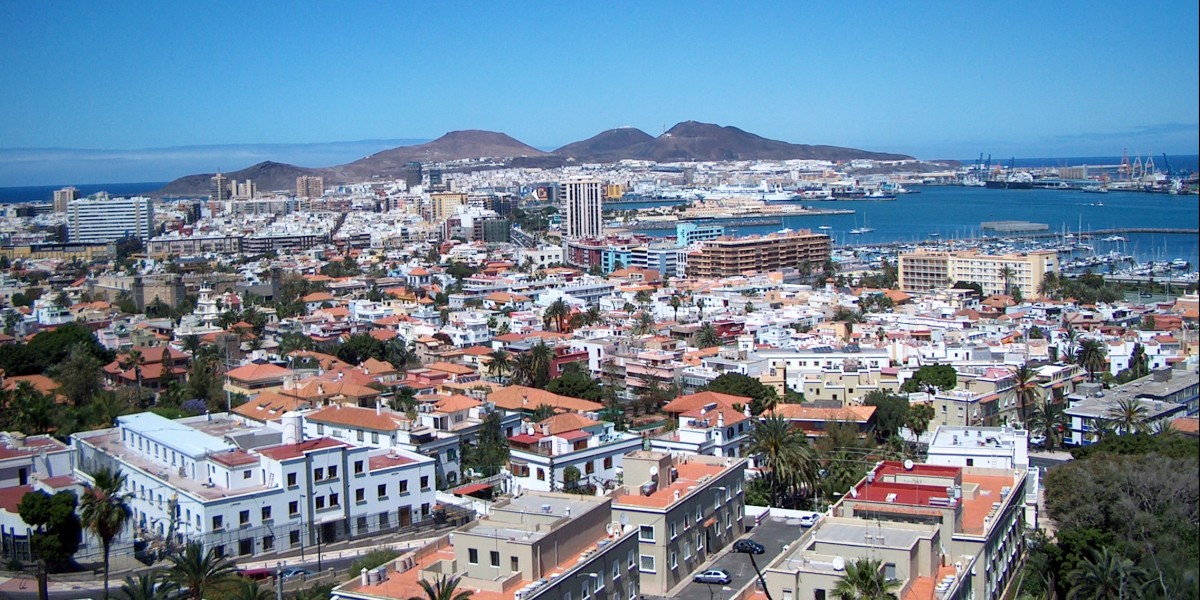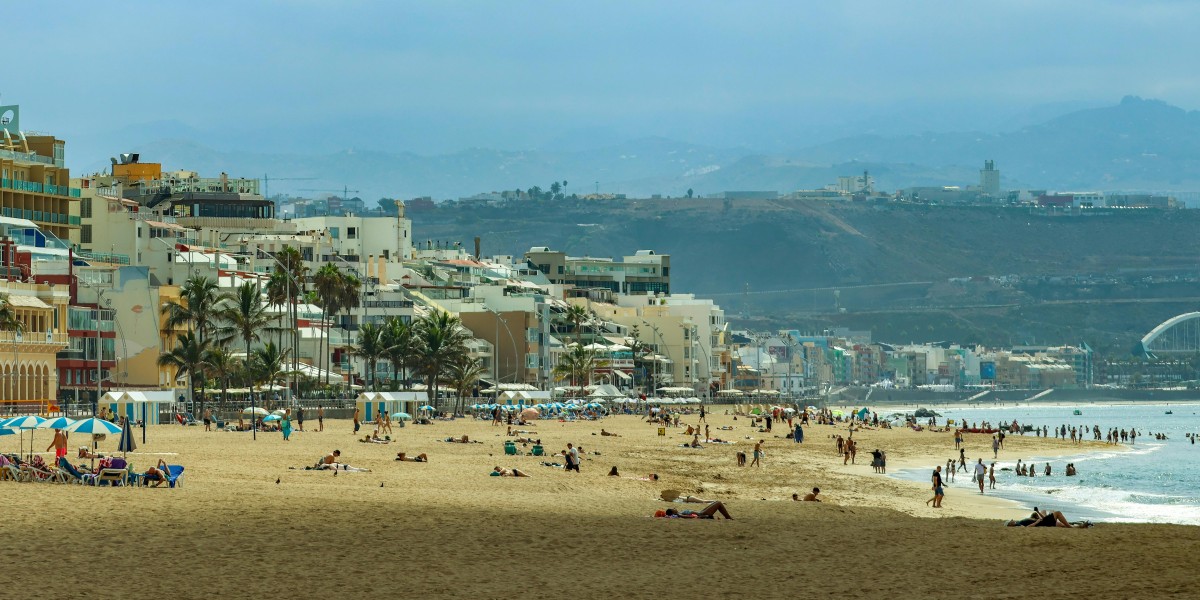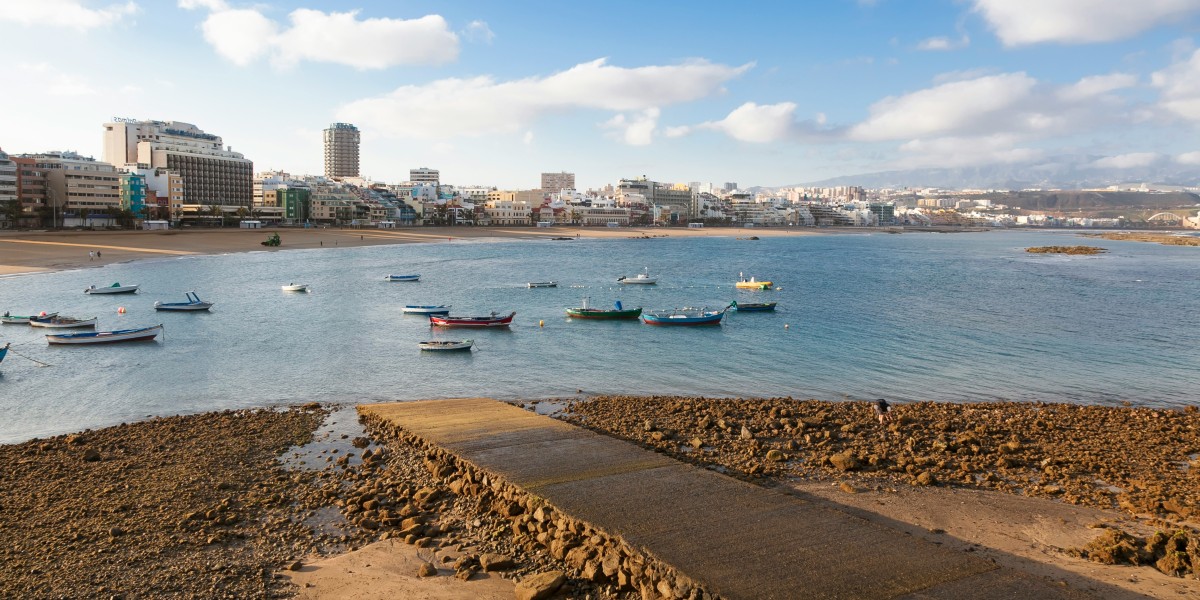
Living in Las Palmas de Gran Canaria means a proper Atlantic city wrapped around the golden curve of Las Canteras Beach, the historic lanes of Vegueta–Triana, and the working port at Puerto de la Luz. Island winds keep summers breezy and winters mild, and there’s surf at La Cícer. About 380,000 people call it home, with plenty of internationals tucked in near the beach and centre.
Is Las Palmas a good place to live?
Las Palmas on the island of Gran Canaria is a solid pick if you want everyday city life with the beach on your doorstep. Walkable pockets around Las Canteras and Triana, a friendly bar‑and‑café scene, cultural anchors like Alfredo Kraus Auditorium and Pérez Galdós Theatre, decent public transport, and a climate that makes outdoor routines easy year‑round.
Trade‑offs are real, however. Expect windy days on the beachfront and fewer direct flights off‑season. Plus, bureaucracy can be fussy, and nightlife noise near the promenade spikes around Carnaval. That being said, remote workers who like a steady routine, families eyeing safe districts, and retirees after temperate weather tend to thrive here.
Living in Las Palmas de Gran Canaria: pros and cons
Arguably one of the best places to live on the Canary Islands, life in Las Palmas de Gran Canaria has plenty going for it, with a few island quirks worth weighing up first.
Some of the pros of life in Las Palmas de Gran Canaria include:
- Year‑round mild weather and daily beach time, with steady surf and a safe, walkable seafront.
- A visible international crowd and an active Las Palmas digital nomad scene, plus reliable fibre internet and solid coworking choices.
- Sensible day‑to‑day costs and varied neighbourhoods, from buzzy areas to quieter family zones.
Some of the cons of life in Las Palmas de Gran Canaria include:
- Windy beachfront days, humidity in older buildings, and the occasional calima dust episode.
- Island logistics: slower deliveries and fewer direct flights off‑season, with rental paperwork that can be a bit fussy.
Cost of living in Las Palmas de Gran Canaria
Day-to-day spending in Las Palmas de Gran Canaria is kind on the wallet. A cheap main course is about €10, a meal for two is around €50, a beer is €3, a cappuccino or coffee €2.10, and a fresh loaf is roughly €1.60.
Getting around is inexpensive too: €1.40 for a one‑way bus ride on the guaguas, €14 for a monthly 80‑journey pass if you're a student, and with contactless, it drops to €0.42 per trip, while retirees ride free across all lines. Expect about €40 for a monthly gym membership and roughly €92 per month for basic utilities on an 85 m² flat.
Property market, rentals and coliving in Las Palmas
Housing tilts the overall picture. As of September 2025, property prices in Las Palmas de Gran Canaria averaged around €2,463 per m², well below San Bartolomé de Tirajana at €4,710 per m² and under the Las Palmas province average of €2,800 per m².
Rent in Las Palmas de Gran Canaria averaged €13.8 per m² in the same month, so an 80 m² apartment comes in at about €1,100 per month. Compared with Madrid or Barcelona, rental prices are considerably lower. The long-term rental market moves steadily year-round, with standard asks including proof of income, a deposit, and sometimes an additional guarantee.
If you’re feeling out the city first or prefer a plug-and-play setup, coliving in Las Palmas tends to cluster near Las Canteras and the centre. Coliving initiatives offer private rooms or studios with fast fibre, shared kitchens, and community events. It’s pricier per night than a standard lease or cheap rooms for rent in Las Palmas, but flexible for digital nomads staying for a few months.
- Property for sale in Las Palmas de Gran Canaria
- Long-term rentals in Las Palmas de Gran Canaria
- Rooms for rent in Las Palmas de Gran Canaria
Best areas to live in Las Palmas de Gran Canaria
The north wraps around Las Canteras for beach-and-boardwalk living, with expats clustering in Guanarteme and parts of La Isleta. The historic core is all culture and character, and there are leafy streets near the marina. For space and newer builds, look inland, and for value and everyday convenience, Schamann and Escaleritas are the sensible picks.
Guanarteme and Las Canteras
Beach-first living, surf, and a lively scene of cafés, tapas bars and coworking around Paseo de Las Canteras and Plaza del Pilar. Housing spans older walk-ups and slick refurbs. Expect a premium price close to the sand, breezy days, and some late-night noise on busy streets.
La Isleta and El Confital
Traditional streets near the port with a creative, bohemian streak and rugged coastal walks over El Confital for sunset swims and picnics. Better value than frontline beach zones, though parking can be tight, and building quality varies block to block.
Alcaravaneras and Ciudad Jardín
Central and residential between the marina and Parque Doramas, with gyms, sailing clubs, and mid-century blocks on leafy avenues. Quieter than the beachfront and handy for schools. The trade-off is traffic on main roads and fewer brand-new builds.
Triana and Vegueta
The historic heart, with boutiques on Calle Mayor de Triana, museums around Casa de Colón, and handsome apartments in renovated Canarian buildings. A joy for architecture and culture lovers. Be aware that parking is scarce, and tourist footfall lifts at weekends.
Siete Palmas
A planned district of newer flats, green spaces and family amenities, anchored by Centro Comercial 7 Palmas and Estadio de Gran Canaria. Modern buildings and easier parking appeal to families and professionals; you’ll drive to the beach.
Tafira
Leafy, low-density living near university campuses with quick access to Caldera de Bandama for weekend hikes. Villas and townhouses suit families wanting space and gardens. Cooler evenings are lovely, but most errands mean a car, and the beach is a commute.
Schamann and Escaleritas
Largely local, practical neighbourhoods with straightforward flats, markets, and solid bus links up to the “ciudad alta”. Good value and everyday convenience. Fewer nightlife options and some hilly streets to factor in.
Living in Las Palmas as a foreigner
Getting set up is fairly straightforward once you know the order. Apply for your NIE, register on the padrón, then open a Spanish bank account for rentals and utilities.
On the money side, remember the Canary Islands' VAT (IGIC) is 7% instead of 21% on the mainland. Healthcare is solid for a city this size, with public hubs at Hospital Universitario de Gran Canaria Dr. Negrín and Hospital Universitario Insular de Gran Canaria, plus private options like Hospital San Roque and Hospital Perpetuo Socorro.
Foreign families tend to look at Canterbury School, British School of Gran Canaria, Oakley College, and American School of Las Palmas when parents prefer their children to go to an international or bilingual school.
Living in Las Palmas as a digital nomad
Las Palmas digital nomad crowd is well served: fast fibre is widespread in beach and central districts, and mobile data is reliable along the coast. You’ll find easy work spots at Restation, The House, The Roof Coworking, GoCoworking and Talleres Palermo.
Community‑wise, there are weekly meetups near Santa Catalina, surf‑and‑work groups, and language swaps that make it simple to plug in. Spain’s digital nomad visa has made longer stays easier, and the GMT/WET time zone keeps European calls civilised.
Where do locals live in Gran Canaria?
Most newcomers in Las Palmas gravitate to Guanarteme–Las Canteras or Triana–Vegueta for a walkable life and easy socialising. However, a lot of locals live in Ciudad Alta, plus practical, well‑connected barrios like Schamann, La Feria, Escaleritas, La Paterna and Tamaraceite. It’s everyday, good‑value living compared with the beachfront.
Beyond Las Palmas, many Canarios base themselves in Telde (industrial jobs, family housing and coastal pockets like La Garita), Arucas (handsome old town and quick GC‑2 hop), and the greener northeast around Santa Brígida and Teror. Up the north‑west coast, Gáldar is growing again, while in the south locals cluster in San Fernando and El Tablero behind the resorts of Maspalomas.
Living like a local in Las Palmas
Life on the Canary Islands runs late. Dinner after nine, a slow Sunday paseo, and festivals anchoring the calendar, with Carnaval in Feb/March the noisiest stretch. On calima days, a warm, dusty wind blows in from the Sahara, so people shut windows and keep plans flexible.
Food is comforting and simple: try papas arrugadas with red and green mojo, sancocho, ropa vieja, the treacly bienmesabe, and a wedge of Flor de Guía cheese. For fresh bits and bobs, wander Mercado de Vegueta or Mercado del Puerto. For day trips, the Agaete valley and Puerto de las Nieves are great for swims and seafood, explore the crater rim at Caldera de Bandama, or the dunes down in Maspalomas.
Live music in Las Palmas pops up week in, week out. Big shows and classical concerts take place in Alfredo Kraus and Pérez Galdós. For bands and late sets, look to The Paper Club, Mojo Club, CICCA, and The Shamrock on the promenade. Open‑air is part of the DNA too: WOMAD brings global acts to Santa Catalina Park, and Carnaval mixes parades with concerts that roll into the small hours.

Stay in the know about living in Spain as a foreigner—get our weekly newsletter for the latest travel, legal, and lifestyle news.
For a taste of the high life, sign up for the monthly luxury market round-up.




